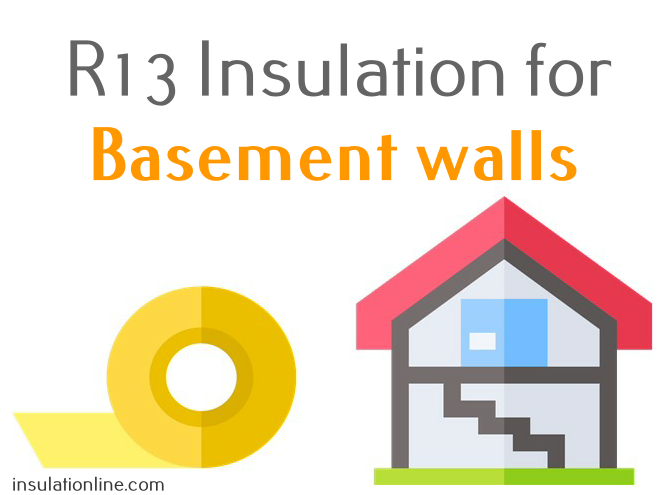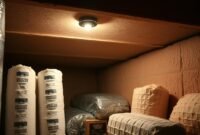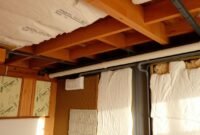Cold, drafty basements can make your home less comfortable and more expensive to heat. Many people face the problem of basement walls that let heat escape. R13 insulation can turn your basement into a cozy and energy-saving area.
I’ll share four key points about why r13 insulation might be just what your basement needs. We’ll look at how it works and how to install it. This guide will help you choose the right insulation for your basement, saving you money and making your home more comfortable.
Ready to see how adding insulation can change your basement for the better?

Understanding R13 Insulation Basics
Insulation is key for a cozy home and saving on energy bills. R13 insulation helps keep your home at a comfortable temperature and cuts down on energy costs. Let’s dive into what R13 insulation is all about.
The R-value is how insulation’s effectiveness is measured. It shows how well a material stops heat from flowing. The higher the R-value, the better the insulation works. R13 insulation is a favorite among homeowners, great for garage walls and other areas.
Read also: Basement Wall Insulation Blanket
Decoding R-Value Fundamentals
Insulation isn’t the same for every situation. R13 insulation is often suggested for certain uses, like:
- 2×4 wall cavities
- Basement wall insulation
- Garage wall temperature control
Is R13 insulation good for walls? Yes, it often is. It strikes a good balance between being effective and affordable. For homes with 2×4 walls, R13 keeps temperatures steady and lowers energy use.
When picking insulation, think about your local climate and building needs. R13 is great for areas with moderate temperatures. It’s perfect for most homes and garages.
Remember, local building codes and energy standards can affect your insulation choice. Always talk to a pro to find the best insulation for your project.
The Importance of Basement Wall Insulation
Homeowners often wonder, “Should you insulate basement walls?” The answer is a clear yes. Insulating basement walls offers many benefits that can greatly improve your home’s comfort and energy use.
Read also: R13 Insulation For Basement Walls
Is it worth insulating basement walls? Definitely. Basements without insulation can lose a lot of heat, raising your energy bills and making your home less comfortable. With the right insulation, your home stays warmer in winter and cooler in summer.
- Reduces energy consumption by up to 20%
- Prevents heat loss through foundation walls
- Improves overall home comfort
- Protects against moisture and mold growth
Insulating your basement also has long-term financial benefits. It can make your home more valuable and protect it from damage over time.
| Insulation Benefit | Impact |
|---|---|
| Energy Efficiency | Reduces heating/cooling costs |
| Moisture Control | Prevents water damage and mold |
| Home Comfort | Stabilizes indoor temperature |
| Property Value | Increases resale value |
I suggest talking to a professional insulation contractor. They can help figure out the best insulation for your basement and local weather.
R13 Insulation For Basement Walls: Installation Guide
Installing R13 insulation in basement walls needs careful planning. Homeowners can insulate their basement walls without framing, saving time and money. The trick is knowing the right techniques for this.
Before starting, I suggest thoroughly preparing your basement walls. Good preparation ensures energy efficiency and prevents moisture issues.
Essential Preparation Steps
To successfully insulate basement walls without framing, follow these steps:
- Inspect walls for any existing moisture or water damage
- Clean walls completely to remove dirt, dust, and debris
- Check for cracks or structural issues that need repair
- Measure wall dimensions accurately
- Purchase appropriate insulation materials
When learning how to insulate basement walls without framing, direct application methods are key. Rigid foam insulation boards are great for basements. They can be attached directly to concrete walls, making a good thermal barrier.
I recommend using adhesive or specialized fasteners for concrete surfaces. This method avoids traditional wooden framing, making installation simpler and reducing moisture traps.
Safety is important during installation. Wear protective gear like gloves, safety glasses, and a dust mask. This protects you from irritants during the insulation process.
Cost Analysis and Energy Savings

Getting r13 basement insulation can really help homeowners save money on energy. At first, it might seem like a big expense. But, the long-term savings are worth it. With good r13 insulation, you could save up to 50% on heating costs.
Here’s a look at the costs of r13 basement insulation:
- Average installation cost: $1,500 – $3,000
- Estimated annual energy savings: $300 – $600
- Potential payback period: 3-5 years
Studies show that homeowners can see big returns on their insulation investment. Several things affect how much you’ll save:
- Local climate conditions
- Home’s existing energy efficiency
- Quality of installation
- Basement size and configuration
Energy experts say r13 basement insulation is a smart choice. It makes your home more comfortable and saves on utility bills. This insulation acts as a thermal barrier, saving you money and boosting your home’s energy efficiency.
Pro tip: Look for local energy rebates or tax incentives to help with the cost. Many utility companies give financial help for making your home more energy-efficient.
Comparing Different Types of Basement Insulation
Homeowners have many choices when picking insulation for basement walls. Each type has its own benefits and challenges. Choosing the right one is key for keeping your home energy-efficient and comfortable.
Knowing about the different insulation materials helps you make a smart choice. Let’s look at the most common options for insulating basement walls.
Fiberglass Batts: A Popular Choice
Fiberglass batts are a classic choice for basement walls. They have several benefits that make them popular:
- Cost-effective solution
- Easy to install
- Widely available
- Good thermal resistance
To help you compare insulation types, I’ve made a detailed comparison table:
| Insulation Type | R-Value | Cost | Installation Difficulty |
|---|---|---|---|
| Fiberglass Batts | R-13 to R-15 | Low | Easy |
| Spray Foam | R-6 to R-7 per inch | High | Professional |
| Rigid Foam Boards | R-5 to R-10 | Medium | Moderate |
Fiberglass batts are affordable but might not be the best for every basement. It’s important to think about moisture resistance and proper installation when choosing insulation.
Moisture Control and Vapor Barriers
Dealing with basement moisture can be a big problem. Vapor barriers are key to keeping your basement dry and safe from mold. Let’s explore how to manage moisture with the right vapor barriers.
It’s important to understand vapor barriers for a dry and healthy basement. These layers stop moisture from getting through walls and causing damage. When you add R13 insulation, picking the right vapor barrier is essential for lasting protection.
- Plastic sheeting is the most common vapor barrier material
- Foil-faced insulation can act as a built-in vapor barrier
- Some specialized membranes offer enhanced moisture protection
Choosing the right vapor barriers depends on several factors. Your basement’s humidity, local climate, and wall type all matter. It’s wise to talk to a local insulation expert to find the best solution for you.
Installing vapor barriers correctly is as important as choosing the right one. Any gaps or tears can ruin the whole system. Make sure to seal and overlap the materials well to keep water out.
- Check for existing moisture before installation
- Seal all edges and seams completely
- Use compatible tape for securing vapor barriers
If you’re watching your budget, investing in good vapor barriers can save you money. They prevent moisture damage, which means no expensive repairs or mold cleanup costs.
Building Code Requirements and R13 Standards
Understanding building codes for r13 insulation can be tricky, mainly for basement and bathroom walls. Each area in the United States has its own rules. Homeowners need to follow these to ensure their insulation is both right and energy-saving.
Local building codes are key in setting insulation standards for homes. When you’re looking at r13 insulation for bathroom walls or basements, knowing the local rules is vital. These rules can change based on where you live.
Regional Insulation Requirements
Insulation needs can differ a lot based on where you are. Climate, local energy laws, and how old the buildings are all play a part. This means different areas have different r13 insulation needs.
- Colder northern states typically require higher R-values
- Warmer southern regions may have more relaxed insulation standards
- Coastal areas often have additional moisture-related requirements
It’s a good idea to talk to your local building department about r13 insulation. They can tell you exactly what you need for bathroom walls and basements. Each place might interpret national codes a bit differently.
| Region | Minimum R-Value | Special Considerations |
|---|---|---|
| Northeast | R-13 to R-15 | High insulation requirements |
| Southeast | R-11 to R-13 | Humidity protection important |
| Midwest | R-13 to R-19 | Extreme temperature variations |
| Southwest | R-11 to R-13 | Heat resistance is key |
Knowing about these differences helps make sure your insulation meets local codes. It also makes your home more energy-efficient.
Common Installation Mistakes to Avoid
Many homeowners make big mistakes when insulating their basements. These errors can cost you time, money, and cause future problems. Knowing what these mistakes are can help you avoid them.
Insulating your basement needs careful work. Here are the top mistakes to watch out for:
- Skipping moisture barrier preparation
- Neglecting air seal gaps
- Improper material selection
- Incomplete wall coverage
One big mistake is not controlling moisture well. Your insulation needs a strong vapor barrier to keep moisture out. Without it, you might get mold and damage your basement.
| Mistake | Potential Consequences | Prevention Strategy |
|---|---|---|
| Incomplete Air Sealing | Energy loss, reduced insulation efficiency | Thoroughly seal wall cracks and gaps before insulation |
| Inadequate Vapor Barrier | Moisture damage, mold growth | Install continuous, sealed vapor barrier |
| Incorrect Material Selection | Poor thermal performance | Choose insulation suited to basement environment |
Experts say to check your basement well before starting. Look at your basement’s needs and pick the best insulation. Don’t rush it, or you might have to fix expensive problems later.
Good basement insulation means being precise and detailed. By avoiding these mistakes, you’ll make your basement more energy-efficient and cozy.
Professional vs DIY Installation
Homeowners must decide whether to install r13 insulation for garage walls themselves or hire a pro. Each choice has its own benefits and challenges. These can affect how well your garage is insulated.
Installing r13 insulation yourself can save money. If you know a bit about building, doing it yourself might seem good. But, hiring a pro can avoid expensive mistakes.
Installation Cost Breakdown
Let’s look at the money side of installing r13 insulation yourself versus hiring a pro:
| Installation Type | Estimated Cost | Skill Level Required |
|---|---|---|
| DIY Installation | $1.50 – $3 per sq ft | Moderate |
| Professional Installation | $3 – $6 per sq ft | Expert |
When choosing between DIY and hiring a pro for r13 insulation, think about these things:
- Your skill level
- How much time you have
- How hard the job is
- If you’ll get a warranty
Professionals know a lot about insulation. They make sure everything is done right, like the vapor barrier. They can spot problems you might miss. Even though they cost more, the benefits last longer.
Long-Term Performance and Maintenance

Thinking about R13 insulation for your garage or basement? It’s important to know how it performs over time. Installed right, R13 insulation can last 20-30 years with little upkeep. This makes it a solid pick for those wanting to save on energy.
Read also: How Long Does Attic Insulation Last?
Keeping an eye on your insulation is key. I suggest checking it every 3-5 years for:
- Moisture damage
- Compression or settling
- Pest infiltration
- Visible wear and tear
If your R13 insulation is failing, you might see higher energy bills or uneven temperatures. Also, look out for any damage. While R13 works well in many places, keeping it up can make it last longer.
| Maintenance Frequency | Recommended Actions |
|---|---|
| Every 3-5 Years | Visual inspection and moisture check |
| 10-15 Years | Comprehensive insulation evaluation |
| 20-30 Years | Consider partial or full replacement |
Regular upkeep keeps your insulation working well. It helps keep your home energy-efficient. By doing routine checks, you can get the most out of your R13 insulation and cut down on energy costs over time.
Alternative Insulation Methods for Basement Walls
Looking for insulation for your basement walls? R13 isn’t your only choice. There are other methods that might be better for your needs.
Spray foam insulation is a great option for basement walls. It seals air and keeps moisture out. There are two main types:
- Open-cell spray foam – lighter and more affordable
- Closed-cell spray foam – better at keeping moisture out and higher R-value
Rigid foam boards are another good choice for insulation. They offer strong thermal resistance and control moisture well.
| Insulation Type | R-Value per Inch | Moisture Resistance | Cost |
|---|---|---|---|
| Spray Foam (Closed-Cell) | 6-7 | Excellent | High |
| Rigid Foam Boards | 4-5 | Good | Moderate |
| Fiberglass Batts (R13) | 3.5 | Poor | Low |
Before choosing insulation, think about your basement’s conditions. Consider moisture, budget, and climate. Getting advice from a pro can help you pick the right insulation for your basement walls.
Conclusion
Exploring R13 insulation for basement walls has shown it’s more than a home fix. It’s a smart move for saving energy, feeling cozy, and keeping your home strong. The right R13 insulation can turn a chilly, damp basement into a warm, inviting spot. It also cuts down on your energy bills.
It’s clear that how you install R13 insulation matters a lot. Homeowners need to think about keeping moisture out, following local building rules, and what their home needs. R13 insulation isn’t a one-size-fits-all deal. But with the right planning, it can make your home much better at keeping warm or cool.
Whether you hire pros or do it yourself, getting ready and paying attention to the details is key. Knowing about R-values, moisture barriers, and possible issues helps you make a good choice. Your basement can become a cozy, energy-saving area that boosts your home’s value and lowers your monthly bills.
In short, choosing quality R13 insulation for your basement walls is a wise move for any homeowner. With the right steps, you’ll have a more comfortable, energy-smart home that handles temperature changes well.


